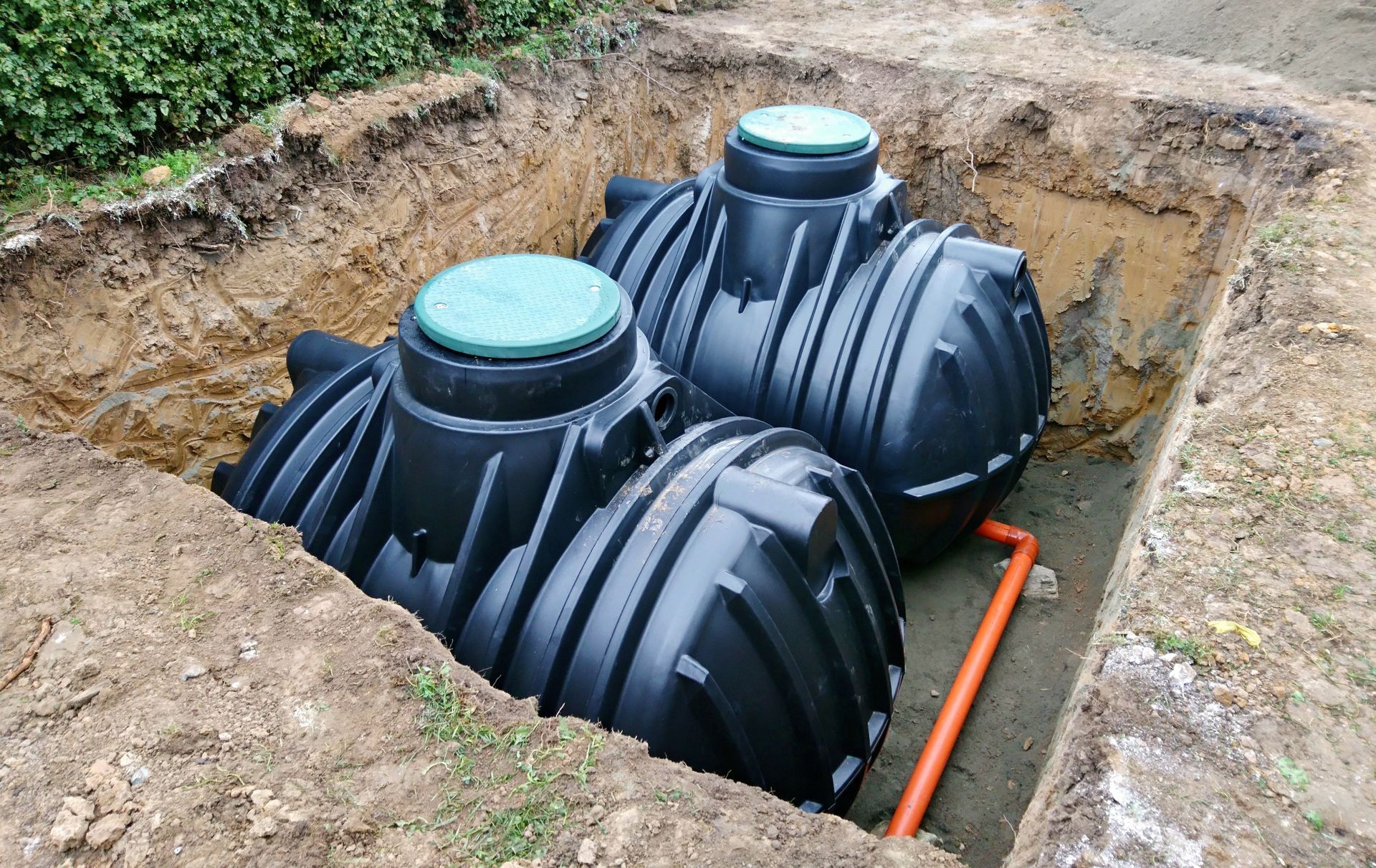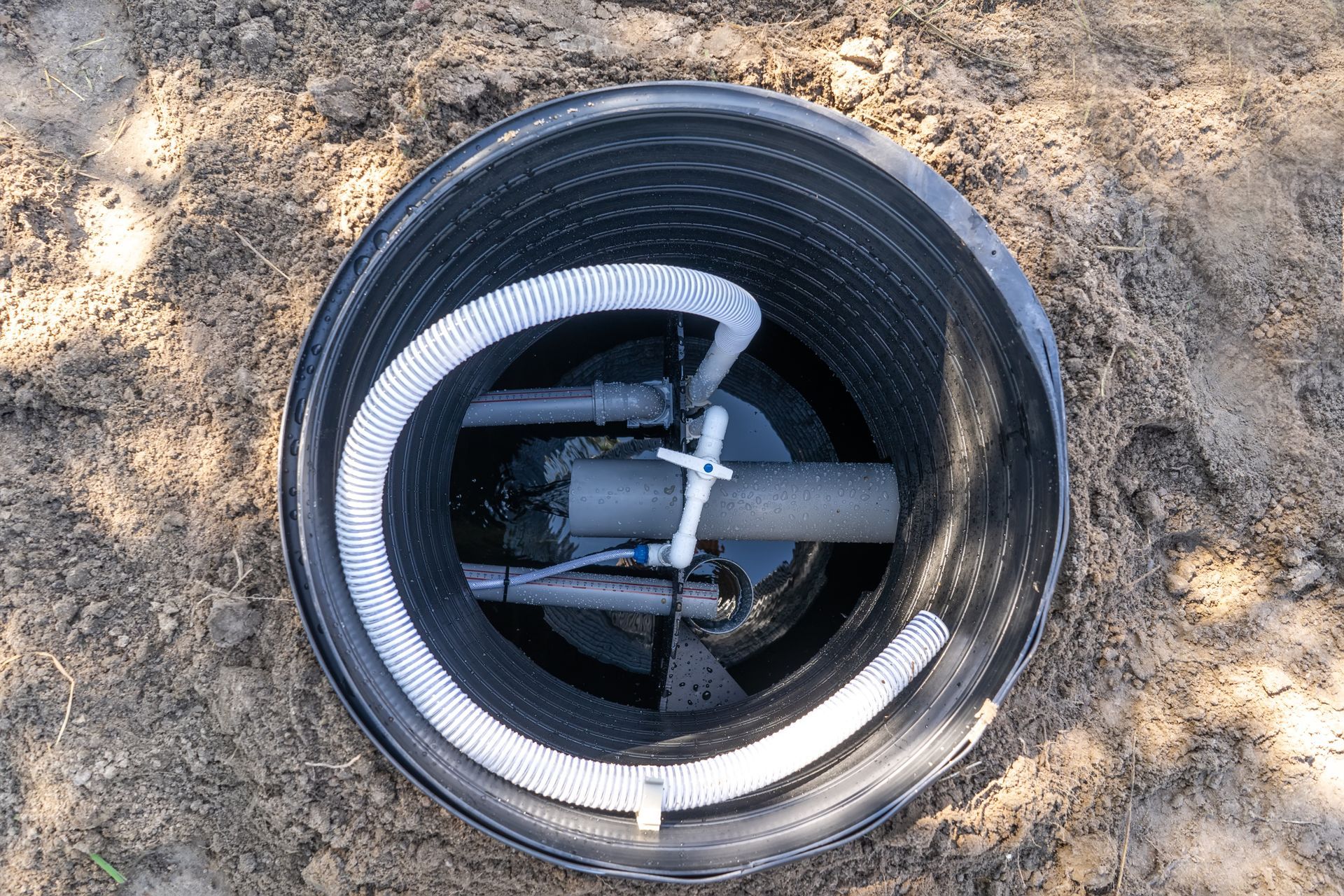Septic Tank Installation & Replacement
Choosing the Right Septic Tank for Your Property

Septic tanks come in various types, each with its own advantages and suitability for different property sizes and usage needs. Here are some common types:
- Conventional Septic Tanks: These are the most basic type of septic tanks and consist of a single compartment where solid waste settles at the bottom and forms sludge while the liquid waste flows out into the drain field. They are suitable for smaller properties with lower wastewater output.
- Anaerobic Septic Tanks: Anaerobic septic tanks use bacteria that thrive in environments without oxygen to break down waste. They are effective in treating wastewater but may require regular maintenance to ensure proper functioning. They are suitable for properties of various sizes but are typically more cost-effective for smaller properties.
- Aerobic Septic Tanks: Aerobic septic tanks introduce air into the tank to promote the growth of aerobic bacteria, which are more efficient at breaking down waste compared to anaerobic bacteria. They are suitable for larger properties or properties with higher wastewater output, as they provide better treatment of wastewater. However, they require more maintenance and may be more expensive to install.
- Multi-compartment Septic Tanks: These tanks have two or more compartments, allowing for better separation of solids and liquids. This helps in more effective treatment of wastewater and reduces the risk of clogging or overflow. Multi-compartment tanks are suitable for properties of various sizes, especially those with irregular wastewater flow or varying usage patterns.
- Concrete Septic Tanks: Concrete septic tanks are durable and long-lasting, making them suitable for properties where longevity is a priority. They are available in various sizes to accommodate different property sizes and usage needs. However, they may be more expensive to install compared to other types of tanks.
Get a free quote
Contact Us
We will get back to you as soon as possible.
Please try again later.
6. Fiberglass Septic Tanks: Fiberglass tanks are lightweight, durable, and resistant to corrosion, making them suitable for various property sizes and soil conditions. They are easier to install than concrete tanks and offer similar longevity. Fiberglass tanks are a good option for properties where access may be limited or where corrosion is a concern.
7. Plastic Septic Tanks: Plastic tanks are lightweight, easy to install, and resistant to corrosion. They are suitable for smaller properties or properties where access is limited, as they can be transported and maneuvered more easily than concrete or fiberglass tanks. However, they may not be as durable as other types of tanks and may need to be replaced more frequently.
When selecting the most suitable septic tank for their property, homeowners should consider factors such as property size, soil conditions, wastewater output, budget, and maintenance requirements. Consulting with a septic system professional can help homeowners make an informed decision based on their specific needs and circumstances. Additionally, local regulations and codes may dictate the type and size of septic tank that can be installed on a property, so it's important to research and comply with these requirements.
Can I replace my existing septic tank, and when might replacement be necessary?
Replacing an existing septic tank is possible and may be necessary under various circumstances. Septic tanks typically have a lifespan of 20-40 years, but factors like poor maintenance, damage, or increased household usage can accelerate deterioration. Signs indicating replacement needs include persistent sewage backups, foul odors, or pooling water around the tank.
Additionally, if the tank is outdated or undersized for the property's needs, replacement may be advisable for better functionality and compliance with regulations. Regular inspections by professionals can assess the tank's condition and determine if replacement is necessary to avoid potential environmental contamination or health hazards.
Are there any regulations or permits required for septic tank installation or replacement?
Septic tank installation or replacement typically requires adherence to local regulations and obtaining necessary permits. These regulations vary depending on location and may involve factors such as tank size, distance from water sources, and soil conditions.
As Septic Tank Cleaning Escondido, ensuring compliance with all relevant laws and regulations is paramount. We specialize in navigating the bureaucratic processes, securing permits, and executing installations or replacements efficiently and safely. Our experienced team prioritizes environmental protection and customer satisfaction, delivering reliable services that meet both legal requirements and industry standards for septic system installation and maintenance.
Having an Emergency?
We're available 24-hours a day, 7 days a week.
Factors to Consider Before Installing a Septic Tank
Septic tank installation is a significant decision for homeowners, impacting both property value and environmental sustainability. Before proceeding, several crucial factors warrant consideration to ensure a successful and efficient installation process. Here are some key aspects to ponder:
- Regulatory Compliance: Familiarize yourself with local regulations and zoning laws governing septic tank installations. Compliance with these regulations is essential to avoid legal issues and ensure environmental protection.
- Soil Composition and Percolation: Conduct a soil percolation test to assess the soil's ability to absorb liquid waste. Soil composition directly affects drainage efficiency, influencing the size and design of the septic system.
- Site Evaluation: Thoroughly evaluate the installation site, considering factors such as topography, proximity to water bodies, and accessibility for maintenance and pumping trucks. Choose a location that minimizes environmental impact and adheres to setback requirements.
- Tank Size and Type: Select an appropriately sized septic tank based on household size, water usage, and soil conditions. Evaluate different tank materials (e.g., concrete, fiberglass, plastic) based on durability, cost-effectiveness, and maintenance requirements.
- Drain Field Design: Design the drain field according to local regulations and soil conditions, ensuring proper wastewater dispersal and preventing groundwater contamination. Factors such as slope, vegetation, and distance from the tank are critical considerations.
- Proximity to Water Sources: Maintain a safe distance between the septic system and wells, streams, lakes, or other water bodies to prevent contamination. Adhere to setback regulations and consider potential impacts on groundwater quality.
- Professional Installation and Maintenance: Hire licensed professionals with experience in septic system installation and maintenance. Proper installation and regular servicing are essential for system longevity, functionality, and compliance with regulations.
- Cost Considerations: Evaluate the total cost of installation, including excavation, materials, labor, permits, and ongoing maintenance expenses. Factor in long-term costs associated with repairs, pumping, and potential upgrades.
- Future Expansion and Upgrades: Anticipate future needs such as property expansion or increased wastewater generation. Design the system with scalability in mind, allowing for future expansions or upgrades without significant disruptions or expenses.
- Environmental Impact: Consider the environmental impact of the chosen septic system, including its energy consumption, carbon footprint, and potential effects on local ecosystems. Explore eco-friendly alternatives or technologies to minimize environmental harm.
By carefully considering these factors and consulting with professionals, homeowners can make informed decisions regarding septic tank installation, ensuring compliance, efficiency, and environmental responsibility. Investing time and resources in proper planning and implementation can lead to a reliable and sustainable wastewater management solution for years to come.
Take action now to maintain a clean and eco-friendly system.
Location
Call
All Rights Reserved | Septic Tank Cleaning Escondido | Powered by Snapps

